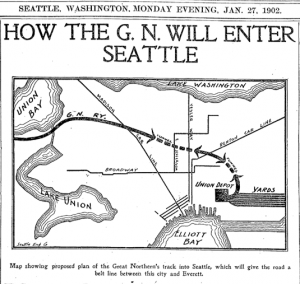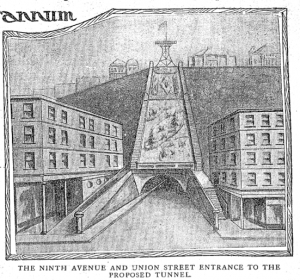“As a result of its rugged topography, the city of Seattle has a class of engineering problems peculiarly its own,” wrote George Holmes Moore. He, of course, was referring to the desires of Seattle citizens to travel more easily through the city. The only solution was to move massive amounts of dirt out of the way and create better access. Holmes’ sentence was written in March 1910. He was referring to what until Bertha bit it, or couldn’t, was Seattle’s most famous digging scheme, the regrading of Denny Hill.
As with Bertha, the removal of Denny Hill at the north end of downtown Seattle was big news across the country. The reports describe the blasting away of 5.5 million cubic yards of dirt as a beautiful thing, necessary to the survival of the city. As H. Cole Estep wrote in Industrial Magazine, “This is a tremendous task for a community so young in years; but the citizens, having an abiding faith that Seattle is destined to become the New York of the Pacific coast, have taxed themselves cheerfully and heavily in order to finance the undertaking.” Sound familiar? All we need to do is a bit of landscape rejiggering and Seattle will be a world class city. It didn’t happen then.
Most citizens did not actually tax themselves. Only those affected by regrade projects had to pay. They did so through what were known as Local Improvement Districts, where those who owned land in the regrade area paid for the project because they were the ones who would benefit the most by the increased value of their post-regrade property. How much each property owner had to pay was determined by a three-person commission, which, as one can imagine, led to a few issues involving the courts.
Those early landscape remodelers ran into a few underground issues too. Their technology of choice was water, using hydraulic hoses, or giants, to wash away the hills. When they encountered small objects, such as buried forests, mammoth teeth, or once, a suspected meteorite that probably was just a boulder, they would stop and pluck it out, but when they ran into more obstinate objects—usually dense lenses of fine grained sediment—they would turn to the old reliable dynamite, blast the offender to bits, and continue remove the dirt. They had it a lot simpler back then.
Despite cost overruns, lawsuits, deaths, and delays, the city completed the major regrade projects, giving Seattle a new face. I suspect that Bertha will eventually get back on track too but it always amazes me how history repeats itself.
And because my momma done told me to, I am including a link to a story in the New York Times about Bertha.


